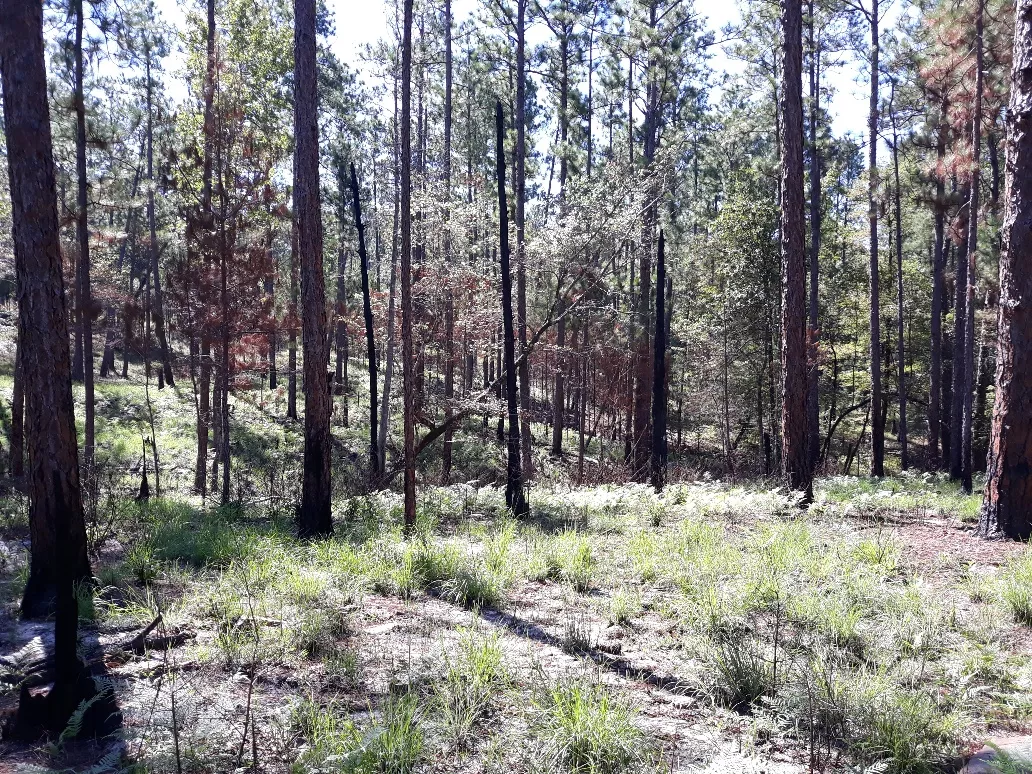On September 14, 2022 the Lone Star Chapter and Houston Regional Group of the Sierra Club (Sierra Club) visited the “Hopson Fire” site in Upland Island Wilderness Area (UIWA), Angelina National Forest. Those present for the Sierra Club included David Boyd, Brandon Sanchez, and Brandt Mannchen.
The “Hopson Fire” was reported on August 9, 2022 to the U.S. Forest Service (FS). There had been multiple fire starts from lighting bursts the day before. Because of private structures about one-half mile away, limited FS resources, low relative humidity levels, increasing and shifting winds, and additional lightning storms that might move into the area, the FS decided to put out the fire rather than let it burn out.
On August 10th a fire line was prepared for about 30% of the perimeter before a storm dropped one-half inch of rain onto the fire. On August 11, 2022, the FS returned to the fire, which had burned about 36.5 acres. Fire activity was minimal due to the rainstorm the day before. The FS completed mopping up the fire on August 13, 2022.
The Sierra Club walked into UIWA and slowly veered northwest toward several streams and a promontory. The Sierra Club found the “Hopson Fire” site and walked through a significant portion of it from south to north. To the east there was a ravine/stream and to the west there was rolling and flat topography.
The Sierra Club observed that woody plants like American Beautyberry, Sweetgum, and Southern Wax Myrtle had burned (seedlings/small saplings) and were resprouting about 36 days after the fire started. Some small areas had not burned. Most of the overstory pine trees seen were Longleaf Pine with a few Loblolly and or Shortleaf Pines.

Midstory Black Gum and Sweetgum had burned or showed the effects of fire via brown leaves and drooping stems. Bracken Fern was growing vigorously in many areas where the fire burned. Some of the flowers that were blooming included: Crow Poison, Pencil Flower, Wild Petunia, Dayflower, Yellow Star Grass, and Flowering Spurge (Euphorbia corrollata).
The Sierra Club saw several seedling Longleaf Pines that were killed or burned or that survived the fire. Ground Skinks were seen in the leaf litter in areas where fire didn’t burn.
On a promontory that burned, there were many blooming orange Butterfly Weeds that had Zebra and other butterflies feeding on them. There were grasshoppers that flushed as the Sierra Club walked the burned area. This promontory had several understory or midstory Blackjack and Bluejack Oaks that were in small clusters or grew as individual trees.
Along streams were many Sweetbay Magnolia and some Royal Fern, indicative of seepage along the lower slopes of the promontories. There was a lot of feral hog activity on the lower slopes and along streams and some on the uplands. White-Tailed Deer tracks and Yellow-bellied Sapsucker holes in Sweetgums were seen.
The Sierra Club pointed out two items to the FS that may be of concern.
The first item was that a large living Longleaf Pine tree was cut with a chainsaw in UIWA. This pine tree may have had a rotten base (it was hard to determine) but the FS “Hopson Fire” report indicated that only snags, which are dead standing trees, were cut via chainsaws and not living trees.
It appeared that this tree should have been left alone since there was a lot of room to work around it where the fire burned, and it was living and not a snag. If living trees are cut in UIWA, then the “Hopson Fire” report should state this and not give the impression that only snags were cut.
The second item was that on some slopes where fire occurred (either prescribed or wildfire), there were small, stair-step, overland flow erosion pathways. These erosion pathways appear to bring sandy soil down slope toward and into streams. This could result in sedimentation of streams.
The Sierra Club continues to conduct “Forest Watch” activities to ensure that wilderness is protected. If you have questions or want further information, contact Brandt Mannchen at brandt_mannchen@comcast.net.
Photos by Brandt Mannchen.